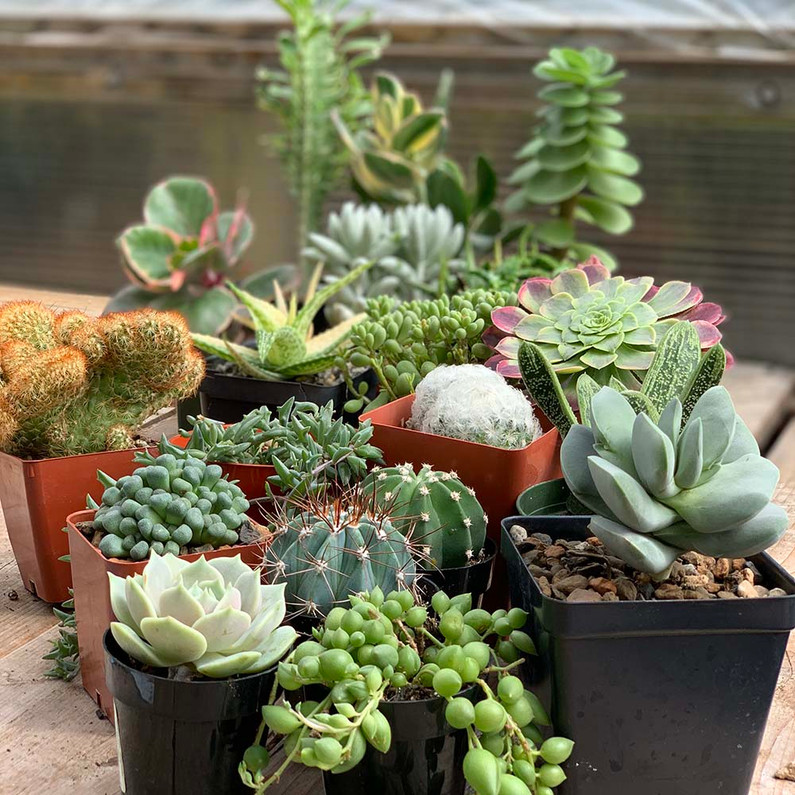Succulents: 101
Succulents: 101
You have a new succulent from East Austin Succulents! - so, what now?
Here are some basic tips for Soil, Water, Light, Pests, & Fertilizer for your new succulent plant!
Soil
Succulents typically love “bad soil,” that which tropical plants and herbs might find downright hostile. At East Austin Succulents, we prefer to pot our own plants in our EAS Succulent Gold Mix: a pre-made cactus & succulent potting medium. A mix like this should contain all the essentials for these desert dwellers: [INORGANICS] for fast drainage and [ORGANICS] which provides a small amount of richness. You should aim for a soil mix that goes completely dry 12-36 hours after a full soak.
Watering
Watering amounts and timing can be tricky, and depend on a lot of factors such as temperature, humidity, air flow, time of year, amount of light the plant is getting, and more. Overwatering is one of the fastest ways to kill a succulent, so it is best to keep a close eye and water only when the plant needs it.
Whether you bottom water or pour from above, drainage holes in your pots are recommended to ensure that moisture does not linger. Once the soil is completely dry, study your plant and take note of the details. If it has shrunk, turned wrinkly, or greyed out, it might be ready for another drink.
Also when watering, remain mindful of the weather: hot, dry plants will be thirstier more often, and cold, wet plants will be at risk of rot.
Light
As a general rule, most succulents thrive indoors on a southern-facing windowsill which will provide plenty of light while cutting down the heat a bit. If placed outside, we’ll want to find a spot which receives soft morning and late afternoon sun while protecting them from the harsh midday exposure. Some cacti and succulents may even thrive in spots that remain lit from sunrise to sunset.
If the plant seems leggy or lanky, it may be stretching for more light. Move it slowly over the course of a week, moving a bit closer to higher light each day. Plants moved too quickly might be at risk of discoloration, yellowness, or corking which is usually permanent but rarely fatal.
Pests
Spider mites, mealy bugs, and scale are among the most common pests you might encounter. Be on the lookout for sudden leaf discoloration that spreads around the plant as well as any physical abnormalities such as sticky webs or white residue. Thankfully, many of these can be removed mechanically with a strong blast of water or a 50/50 mix of alcohol and water in a spray bottle. Stubborn infestations may be a test of persistence - stay strong!
Fertilizer
Most cacti and succulents do best with a low dose of fertilizer applied every watering during their growing season and none at all whenever they’re at rest. Look for a fertilizer where the numbers on the label match (ex. 10-10-10) and half the recommended dosage… then half it again - they should love this! We’ve also noticed that succulents love fish tank water which is a conveniently organic cornucopia of fish and snail waste.
We hope this was helpful.
Also, we send very basic care cards in all our East Austin Succulent plant orders! (image below)

Recent Posts
-
Succulent Care Card
Our Basic Succulent Care Card This information is our broad advice for most succulents and cact …Jun 14th 2023 -
Repotting Cacti into the Right Soil
Repotting Plants that come in Peat MossBig box stores usually pot a cactus in peat moss which retain …Jan 18th 2023 -
Quartz Crystals and Their Meanings
Crystals: QuartzHere at East Austin Succulents, we pride ourselves on carrying the best selection of …Sep 7th 2022




